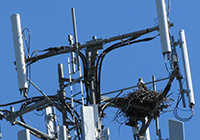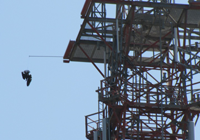
Osprey in nest
The treatment of nest sites is highly dependent on the status of the nest (active or inactive), the species of bird inhabiting the nest and the state in which the site is located. An active nest is defined as a nest containing eggs or flightless young; conversely, an inactive nest contains no eggs or flightless young.
Protocol for Eagles vs. other Migratory Bird Species
Eagles
At any known eagle nest site, a hold is placed on all work during active nesting season based on USFWS buffer zone guidelines. When work needs to be completed during eagle nesting season, American Tower works with biologists to evaluate the site to determine the nest status. If the nest is inactive and the proposed work can proceed, the Bird Watch team will issue an Eagle Site Conditional Work Approval. If the biologist’s evaluation determines that the nest is active, the work may not proceed. The Bird Watch team will track the status of the nest and will provide an approval to the customer or contractor once the nest has been determined to be inactive. If a customer determines that failure to complete their work while the nest is active may pose a significant risk to either human health and safety or eagle health and safety, the Bird Watch team will consult with the state and federal agencies on how or when the work may proceed.
Other Migratory Bird Species
For customer work that is being completed at non-eagle sites, the Bird Watch team will provide Bird Site Work Advisory or Threatened or Endangered Species Work Advisory. Please log in to our site access application to request access. In the unlikely instance that access is not granted, please email bird.watch@americantower.com.
State requirements related to treatment of bird activity at our sites may be more stringent than federal requirements. In some states, a depredation permit is required before work can proceed at a site with an active nest. Additionally, some states may require a permit to remove an inactive nest. A statement from a qualified biologist regarding current nest activity status is often required for these state and federal permit applications.

Vulture effigy hung to deter
roosting birds
Protocol for Roosting Sites
At some sites there may be no nest, yet large numbers of birds may use the tower as a roosting place. All reported roost sites will be evaluated, and a treatment plan may be implemented based on the number of birds in the roost, amount of site or property damage and other pertinent factors. Treatment plans will be developed with input from qualified biologists as needed. Treatment will generally consist of the installation of deterrents to prevent the birds from landing on the tower. Some deterrents include effigies, audible deterrents, propellers or other humane roosting preventions.
Protocol for American Tower Contractors or Employees
Prior to completing any tower work at a nest site, all American Tower contractors or employees must have a Bird Site Conditional Work Approval. Please contact our Field Operations Technician if you do not have this approval.
To determine the current status of a nest, the species of bird occupying the nest and the appropriate treatment protocol to employ, the American Tower Environmental team will work directly with professionals who have the recognized level of expertise necessary to make independent determinations. In order to keep each bird site’s information as current as possible, we rely on information from a variety of sources, including American Tower Field Operations Technicians, our customers, contractors completing work and the general public. American Tower will also work with the U.S. Department of Agriculture (USDA) Wildlife Services, state wildlife agencies, the U.S. Fish and Wildlife Service, private consultants and qualified bird watchers in each state.
